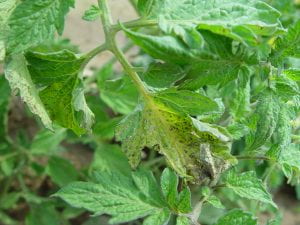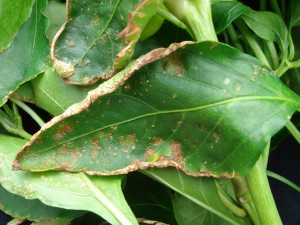
Bacterial canker is a systemic disease of tomatoes caused by the bacterium Clavibacter michiganensis subsp. michiganensis. It can occur in fresh market and processing tomatoes, in open fields, and in protected culture systems like greenhouses and high tunnels. Symptoms are stunting of whole plants, which never reach their full potential, plant death, foliar lesions, “firing” on leaf margins, and raised scabby lesions on fruit. Seeds are a major means of introducing the canker pathogen into a tomato crop, but the bacteria can survive in the field for several years, as well as on surfaces such as greenhouse walls or floors, tools, stakes, clips or ties, etc. Several cases of tomato canker have come into our diagnostic lab this summer; since the bacteria clog the plants’ water-conducting vessels, the stunting symptom may be more severe in the hot, dry weather we’ve experienced for much of this year’s growing season.

Peppers are also susceptible to bacterial canker, but the disease is not systemic in peppers so the stunting symptom does not occur. However, the firing of the leaf margins and leaf and fruit lesions do occur. Symptoms of bacterial canker on peppers are different than those on tomatoes (see figures). The bacteria that infect
Start with clean seed – For purchased seeds, buy certified, disease-free seed or sanitize seed with hot water (recommended), dilute bleach, or hydrochloric acid. It is especially important to sanitize saved seeds, such as for heirloom varieties. Here is a link to the OSU fact sheet for Hot Water and Chlorine Treatment of Vegetable Seeds to Eradicate Bacterial Plant Pathogens. In place of water baths for the hot water treatment, relatively inexpensive Sous Vide – type digital water heaters can be used to heat and maintain the water at the prescribed temperature. There are no bactericides or other products that control this disease once it is in the field or greenhouse. This disease is managed primarily through sanitation.

- Keep transplants clean and healthy – Scout tomato and pepper plants daily and destroy plants with canker symptoms once a plant disease diagnostic laboratory has confirmed the disease. Apply one or two preventative copper fungicide applications and one application of streptomycin (conventional systems) to the plants before transplanting them into the field.
- Use clean equipment and tools – Clean and disinfect all tools and farm equipment prior to working with the transplants or plants. Good sanitation practices are critical to prevent contamination and cross-contamination of plants by the bacterial canker pathogen. Quaternary ammonium products and 10% chlorine bleach are suitable disinfectants.
- Start with a clean field – The bacterial canker pathogen can survive in the field as long as there is infected crop debris present. Rotate with a non-host before re-planting the field with a tomato. Ideally, a 3-4 year out of crops in the same family as tomato (pepper, eggplant) should be implemented. Plant into a field free of weeds or volunteer tomato plants.
- Use best cultural practices – Use management strategies that maintain reduced-stress growing conditions. Provide plants with adequate but not excessive nitrogen, improve the organic matter content of the soil through the use of composted green or animal waste or cover crops, use well-drained soil and avoid overhead irrigation if possible.

